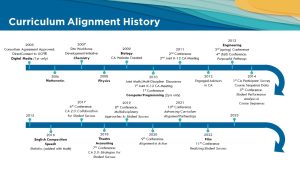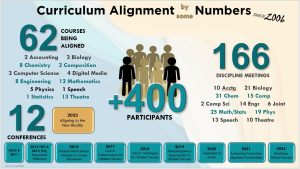
What Is Curriculum Alignment?
An aligned curriculum “refers to an academic program that is (1) well organized and purposefully designed to facilitate learning, (2) free of academic gaps and needless repetitions, and (3) aligned across lessons, courses, subject areas, and grade levels.” (Hidden curriculum (2014, August 26). In S. Abbott (Ed.); The glossary of education reform. Retrieved from http://edglossary.org/hidden-curriculum)
Florida’s statewide 2+2 articulation agreement and the accompanying statewide course numbering system lay the foundational pieces for course articulation. The statewide agreement guarantees that a student who completes an Associate of Arts (A.A.) from a Florida State College will be admitted to one of the state’s universities. Per the statewide articulation manual (2011), “Florida developed a common course numbering system to facilitate the transfer of credit for equivalent courses among the state’s colleges and universities. This system, known as the Statewide Course Numbering System (SCNS) is now used at all public and selected nonpublic institutions of higher education in Florida.” Because courses that have the prefix and number are considered equivalent, the Curriculum Alignment initiative further enhances SCNS by creating space for faculty to collegially engage in conversations to ensure that academic content and learning outcomes are aligned.
History
In November 2005, UCF’s president John Hitt and presidents from Eastern Florida State College, Lake-Sumter State College, Valencia College, and Seminole State College (four partner colleges) signed a joint resolution, which eventually led to the DirectConnect to UCF program. This program guarantees entry into UCF once certain criteria are met for the Associate in Arts or select Associate in Science degrees. As a result, UCF has become the number one destination for transfer students in the nation. Soon after the resolution was signed, the curriculum alignment initiative began.
In May 2006, the Chief Academic Officers from UCF and five partner colleges (Daytona State College also joined the DirectConnect partnership) chose to focus on the disciplines that support national, state and local initiatives to graduate more students in the area of STEM: Science, Technology, Engineering, and Mathematics. At this meeting they discussed ways to align their curriculum. The working group determined to begin with math, asking faculty members to determine which courses should be discussed.
Faculty members from all seven institutions agreed at their first workshop in September 2006 to meet the following January and focus on MAC1105 (College Algebra), MAC1114 (Trigonometry) and MAC1140 (Pre-Calculus Algebra). The focus of these efforts was to find ways to align curriculum, share the best practices, and evaluate assessment tools. Over the first four years, a group of approximately 20 faculty members met to complete a suggested course alignment topic for the various math courses and to agree on topics and outcomes for MAC1114, MAC1140, and Calculus I, II, and III.
From 2006 to 2009, Mathematics, Chemistry, Biology and Physics were the first four disciplines that faculty members and administrators identified as priorities for curriculum alignment. Computer Programming was added in 2010 and engaged in discussions for a few years but is no longer active. In 2013 and encouraged by the fact that UCF had agreements with several articulated degree programs, Engineering joined the discussions. In 2015, a final college – the College of Central Florida in Ocala – joined the DirectConnect partnership. In 2017, Statistics courses were incorporated into the Mathematics meetings, and new disciplines of Speech (Communication) and Composition (Writing and Rhetoric) were added. In 2018, Theatre and Accounting joined the initiative, and Film joined in 2022. These disciplines are engaging in ongoing alignment discussions of lower-division and highly transferable courses. Looking forward, additional disciplines will be invited to engage in faculty discussions to align curriculum.
College and UCF faculty members from each of the disciplines meet with their peers to review curriculum and discuss ways to align content so transfer students are better prepared for upper division courses at the university. The curriculum alignment effort resulted in an unprecedented level of cooperation that expanded to include K-12 administrators and teachers (who have engaged in discussion off-and-on since 2010), partner colleges and UCF, and most importantly has improved student success rates.
Curriculum Alignment Handbook
A Curriculum Alignment Handbook* is now available in its second edition. The 2023 edition includes significant revisions to provide additional context, information and guidance for any partnering institution who wishing to engage in and implement the curriculum alignment process. The authors of the second edition contribute their expertise and experience resulting from over 10 years of facilitating and engaging in the curriculum alignment effort. The handbook is written as a guide for a facilitator with the goal of successfully implementing the alignment work. It provides instruction on developing the alignment team, setting meeting agendas and priorities, managing discussions and ensuring that the course alignment goals are met. The first five chapters are written to provide meeting guidance, the last two provide considerations throughout the process and appendices provide sample materials and information that support the process of curriculum alignment.
The 1st edition of the handbook was originally developed by the Transfer Preparation-Curriculum Alignment Action Team in 2016 as a part of the University of Central Florida’s participation in the John N. Gardner Institute’s Foundations of Excellence (FoE) Transfer Focus Initiative (phase 2).
*If you have difficulty downloading the handbook, please email curriculumalignment@ucf.edu to request a copy.


